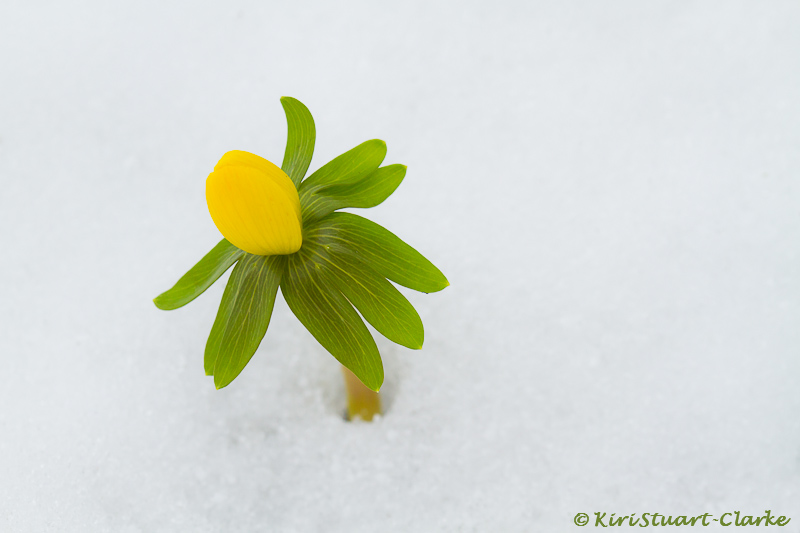Even though we have had thick snow on the ground for a week and a half now there are still faint augurs of spring all around us if you look hard enough. And the sight of this bright yellow Winter Aconite, Eranthis Hyemalis amidst the snow brought me joy.
Gardening Value of Winter Aconite
This delicate, yet plucky little flower is one of the very first plants to flower in the new year; peeking its cheery buttercup-like head bravely out even when it has to tunnel through thick snow to do so, often while the more famously celebrated Snowdrops are still little timid shoots barely starting to make an appearance. As well as resembling a Buttercup, Winter Aconites are also related to them being in the Ranunculaceae or Buttercup family.
Winiter Aconites are very versatile adding bright, vibrant colour and interest in the wildllife garden at a barren time. They can work well both in an informal wooodland edge setting, along a hedge or more formally lining a border or pathway. It is very effective for winter ground cover and tubours spread quickly in a carpet-like fashion, not unlike Snowdrops. Aconites will thrive in part or full sun in fertile, moist, humus-rich soil.
Wildlife Value of Winter Aconite
Being such a seasonal pioneer, its early flowering habit makes Winter Aconite a blessing for wildlife, providing an invaluable nectar source for early foraging bees, flies, beetles and other insects, with its cup-shaped flowers affording easy access. It’s a must-have plant in any wildlife garden. As with all Ranunculaceae Winter Aconites are toxic plants to mammals and so resistant to grazing by herbivores such as Rabbits or Deer or Field Mice.
Plant Folklore of Winter Aconite
Eranthis Hyemals is a non-native perennial, originating in Southern Europe and the Balkans. It was first introduced in the 16th Century (1596), became fashionable in 18th century landscape gardens including those of Lancelot “Capability brown”. This encouraged naturalisation, with it first being recorded in the wild in 1838. Winter Aconites can be found in many parks and woodlands across England particularly South of the Midlands and in the East of England.
Early herbalist John Gerard listed the Winter Aconite as "Winter Wolfes-bane or Small Yellow Wolfes-bane” in his 1636 “Herbal, Historie of Plants” and incorrectly placed it in the Aconitum family within Ranunculaceae, which includes Wolfsbane, Aconitum napellus. He described Winter Aconite thus: “whole leaves come forth of the ground in the dead time of winter, many times bearing the snow on the heads of his leaves and flowers, yet the colder the weather is, and the deeper that the snow is, the fairer and larger is the flower”.
He also remarked upon its peculiar claimed virtue of sedating scorpions “it is reported to prevail mightily against the bitings of Scorpions, and is of such force, that if the Scorpion passes by where it groweth and touch the same, presently he becommcth dull, heavy,and (de)fence!ess”. English playwright Ben Jonson (1572-1637), also alluded to this alleged trait in his tragedy Sejanus in 1603, which includes the lines: “I have heard that Aconite / Being timely taken hath a healing might / Against the scorpion's stroke.” however this may stem from Winter Aconite’s early incorrect classification as a “true” Aconite and confusion with the deadly poisonous Wolfsbane, Aconitum napellus. Who knows, perhaps that is what Gerard took as his source!
Winter Aconite’s scientific name, Eranthis hyemalis, was establied by Salisbury in 1807 and stems from the Greek “er”, meaning ‘spring’ and “anthos”, flower added to hyemalis, the latin for ‘winter-flowering’. However its common name “Winter Aconite”, still refers back to the similarity of its leaf shape to plants in the Aconitum genus, this being the feature mostly used to classify plants before scientific methods were introduced.
Local folklore names for Winter Aconite include “Christmas-rose” (Somerset) and “New-year’s Gift” (Essex) for its seasonal timing, “Choirboys” (Essex) alluding to the foliage “collar” surrounding its flower-head. Also “Devi’s-wort” (Somerset) perhaps due to its poisonous nature.
For me, the little Winter Aconite is a symbol of hope and cheer when everything around is still bleak and harsh and, for that, I love it all the more.
Sources
Gerard, The herball, or, Generall historie of plantes
https://archive.org/stream/herballorgeneral00gera#page/966/mode/2up

